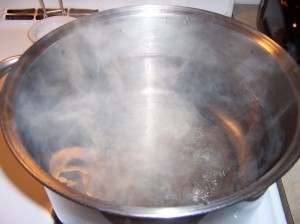We’ve been enjoying Kombucha in the house on a regular basis for a couple of years now. I don’t make it, my wife Lisa Marie does. This entry on how she makes the kombucha has been in the works for nearly a year — let me publicly apologize for taking so long to post this. Thanks to Lisa Marie for outlining her method on kombucha for bardicbrews.net readers.
Kombucha is “an effervescent fermentation of sweetened tea.” But rather than using yeast to “eat” the sugar and create alcohol, we use something called a SCOBY. SCOBY stands for Symbiotic Culture Of Bacteria & Yeast. It is a coherent structure, almost like a “blob” or a collection of slime that looks like this:
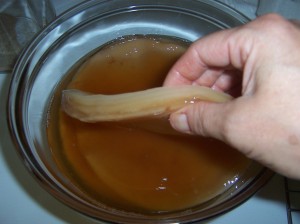
In general it is best to get a SCOBY from someone willing to barter; paying for these things (unless it’s like a buck or something) is just dumb. Wrong energy, at least in Lisa Marie’s opinion. If you don’t know where to start, don’t start on the ‘net. Ask around at local health food stores, etc. You meet some of the coolest people this way. : )
You will also need a container for fermenting, NOT a carboy with an airlock. We prefer a traditional crock. We have also used a glass gallon jar, but didn’t get as nice a ferment out of it. Perhaps it was too much exposure to light? We don’t recommend using anything metal. Metal should never come in contact with your SCOBY or your fermented beverage. Check around yard sales or flea markets for cool crocks.
As always, use the best water you can. If there is fluoride or chlorine in your water it won’t help your brewing in any way.
Kombucha is also made with tea. We use the store brand of organic black tea. We prefer a caffeinated black or green tea to make my kombucha, though there are several variations and combinations of herbs and teas that could be used. This is where the internet is quite helpful. There are so many people experimenting with kombuchas these days, which is fantastic.
You will also need sugar. The type of sugar one should use is controversial. No, you can’t use honey because honey is an antibacterial and will kill your SCOBY. Different sugars will give you different-tasting kombuchas. Our advice is to always go as local as possible and use something as unrefined and as organic as possible. We use organic cane juice. I’ve been jonesin’ to try a local maple sugar. Maybe someday soon!
Add-ins… This is where the fun starts. The one we’ve been stuck on recently is Rosehip Kombucha. It’s fun to experiment, but definitely do your research first. Some plants and mushrooms are antibacterial and/or antiviral. Keep those away from your SCOBY! Add-ins can be added to the tea during fermentation (like the rosehips) or to the bottle before filling with the fermented tea (like spirulina powder, cider, or grated fresh ginger).
You will also need bottles, and other supplies like a funnel and a ladle. We prefer Grolsch bottles because they are easy to use, are re-usable, and don’t require new caps periodically. For making the tea you will need a wooden spoon and a strainer. Lastly, you will need a thin cloth like a handkerchief or a cloth napkin and a rubber band to cover the crock during fermentation.
The Process
This recipe for Rosehip Kombucha makes 1 gallon or about 6 12-oz. Grolsch bottles’ worth of ‘booch.
1. Boil 1 gallon of water:
2. Turn off heat and add 1 c. sugar, 5 tea bags (or approximation of equivalent tea), and a couple handfuls of dried rosehips:
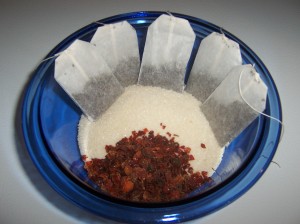
3. Stir well with wooden spoon and let steep with lid on. If you are using black tea, do not let this steep for more than 10 minutes. Our research has shown that steeping times longer than 10 minutes release unhealthy amounts of fluoride into your teas.
4. Strain tea into crock:
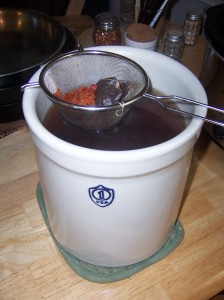
5. Cover with cloth and rubber band and let cool to room temp (test with pinky):

6. When cool to room temp, stir in (with your wooden spoon) about 1 cup of a previous batch of kombucha. Gently lay your SCOBY [my picture shows a mother with a few babies… some are thicker, some are thinner) on top of the tea mixture. Don’t worry if it sinks. It will eventually rise up in a day or so.
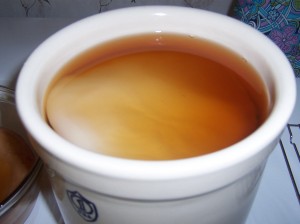
7. Cover with cloth and rubber band and label, if necessary.
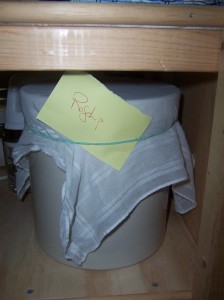
8. Most kombuchas take anywhere from 7-30 days to ferment. We always check ours after about 5 days to see where it’s at. Using a wooden or plastic spoon, take a sample from underneath the SCOBY and taste it. Some people like it more vinegary, some more sweet. When it tastes good to you, it’s ready to bottle.
9. For bottling, we prefer to use Grolsch bottles with re-useable seals at the top. It’s important to ladle the ‘booch slowly, with the bottle turned at a steep angle to preserve carbonation and prevent overflow.
Remember, some kombuchas are fizzy and some aren’t. This has to do with ingredients used and ambient temperature of the room in which you’re storing the kombucha, as well as how much sugar is left in the tea when you bottle. Some of our kombuchas have gone in with no fizz and have opened with quite a bang! To prevent a mess, always open a homebrew kombucha bottle over the sink!
Storage advice varies from person to person. We store ours outside the fridge and put in two each night for the next day. Refrigeration slows fermentation; I still want those yeasties working.
You’re going to get little kombucha stringies (some call them “threads”) or mini-mothers (little SCOBY) in your kombucha. They’re totally fine to ingest – and are actually quite beneficial to the gut! Go ahead: slug ’em back!
Above all, enjoy your ‘booch!

